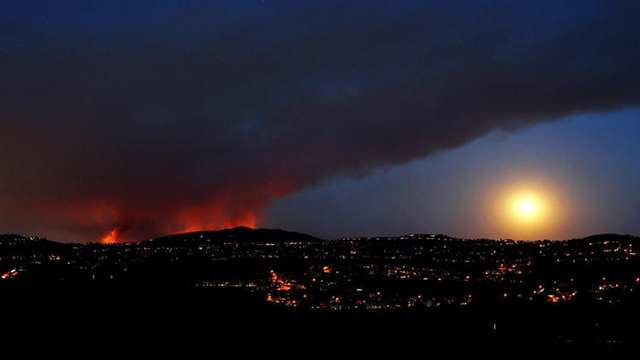Photo gallery: Ash is the new ‘May Gray’ in Southern California
By Rong-Gong Lin II, Rosanna Xia, and Joseph Serna
15 May 2014 (Los Angeles Times) – “May Gray” and “June Gloom” usually offer a cool respite for firefighters as they prepare for the summer and fall’s hot weather and heavy winds.. But for much of this month, May Gray has failed to materialize. Instead of the low clouds and chill common to Southern California around this time, May has brought heat waves and blistering Santa Ana winds. And that has sparked fires like the ones in San Diego County that are considered highly unusual for the month. “Poor May Gray. Everybody whines about it, but they are pining for it now,” said Bill Patzert, a climatologist for NASA’s Jet Propulsion Laboratory. So far this year, California has seen double the number of brush fires than average. Because there was so little rain this year, the moisture level in the brush is incredibly low. The conditions are causing problems across the region. Los Angeles County fire officials have responded to about two dozen brush fires in the past two days.
“Everything is fueled by the heat. So a car fire next to a piece of brush — everything is escalated,” said Keith Mora, an inspector with the Los Angeles County Fire Department. “Anything right now is complicated by the weather.” Small spot fires Wednesday prompted the closure of the 405 Freeway in the San Fernando Valley, the 91 Freeway in Anaheim and the 5 Freeway near Camp Pendleton, clogging traffic for hours. Officials said the tinderbox conditions are forcing them to send large numbers of firefighters to each blaze, regardless of its size. “Our call load has dramatically increased for all the fires,” said Capt. Steve Concialdi of the Orange County Fire Authority. “Even when we have a vehicle fire along the toll road or next to vegetation, we send a lot more units and try to aggressively attack.” Typically, Santa Ana winds begin to hit in October and generally last for a day or two. This Santa Ana pattern is lasting a whole week, Patzert said.
Late-year Santa Anas are tempered by the arrival of winter rains. But Patzert said he doesn’t expect any sizable precipitation for another six months until the forecasted wet El Nino conditions arrive. May Gray and June Gloom are caused by the temperature difference between the land, which is warming up after winter, and the ocean, which is still cooler. The difference produces the flow of cool, moist air from ocean to land. But so far this May, the Santa Ana winds are wiping out the cooler flow of air from the shore. Fire officials said the conditions are the byproduct of three years of bone-dry winters. Downtown Los Angeles is on track to record the seventh-driest year since record-keeping began in the late 1870s, recording only 6.08 inches of rain since July 1, about 40% of the average. The sixth-driest was the previous year, where only 5.85 inches were recorded. […] Cities throughout Southern California shattered or tied decades-old highs for this date. Santa Ana clocked in at a record-breaking 103 degrees; downtown Los Angeles, 102; Long Beach and Burbank, 100; and San Diego’s Lindbergh Field, 94. [more]
Ash is the new ‘May Gray’ in Southern California


